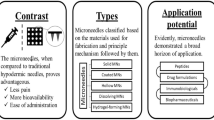Abstract
Purpose
To demonstrate transdermal delivery of interferon alpha-2b (IFNα2b) in hairless rats through aqueous microchannels (micropores) created in the skin and enhanced by iontophoresis.
Materials and Methods
The Altea Therapeutics PassPort™ System was configured to form an array of micropores (2.0 cm2; 72 micropores/cm2) on the rat abdomen. The transdermal patch (Iomed TransQ1-GS-hydrogel) was saturated with an IFNα2b solution (600 μg/ml) and applied for 4 h. Delivery was evaluated with and without cathodic iontophoresis (0.1 mA/cm2). Intravenous delivery (0.4 μg/100 g body weight) was performed to support pharmacokinetic calculations.
Results
IFNα2b was not delivered through intact skin by itself (passive delivery) or during iontophoresis. However, passive delivery through micropores was achieved in vivo in rats. A dose of 397 ± 67 ng was delivered over 6 h, with steady state serum concentrations reaching a plateau at 1 h post-patch application. These levels dropped rapidly after patch removal, and returned to baseline within 2 h of patch removal. Iontophoresis-enhanced delivery through micropores resulted in a two-fold increase in the dose delivered (722 ± 169 ng) in the hairless rat.
Conclusions
In vivo delivery of IFNα2b was demonstrated through micropores created in the outer layer of the skin. Iontophoresis enhanced delivery through microporated skin in hairless rats.




Similar content being viewed by others
References
S. Pestkaand and A. Meager. Interferon standardization and designations. J. Interferon. Cytokine Res. 17(Suppl 1):S9–S14 (1997).
P. Jouet, F. Roudot-Thoraval, D. Dhumeaux, and J. M. Metreau. Comparative efficacy of interferon alfa in cirrhotic and noncirrhotic patients with non-A, non-B, C hepatitis. Le groupe Francais pour l’etude du traitement des hepatites chroniques NANB/C. Gastroenterology 106:686–690 (1994).
S. Schenker, D. Cutler, J. Finch, C. H. Tamburro, M. Affrime, R. Sabo, and M. Bay. Activity and tolerance of a continuous subcutaneous infusion of interferon-alpha2b in patients with chronic hepatitis. C. J. Interferon. Cytokine Res. 17:665–670 (1997).
V. Bocci, F. Carraro, A. Naldini, P. P. Cagol, E. M. Pasqual, C. Prevaldi, and D. Casara. Distribution of human recombinant interferon-alpha 2 in rat plasma, liver, and experimental liver metastases. Mol. Biother. 2:233–234 (1990).
A. Bonettiand, and S. Kim. Pharmacokinetics of an extended-release human interferon alpha-2b formulation. Cancer Chemother. Pharmacol. 33:258–261 (1993).
Y. Yoshikawa, Y. Komuta, T. Nishihara, Y. Itoh, H. Yoshikawa, and K. Takada. Preparation and evaluation of once-a-day injectable microspheres of interferon alpha in rats. J. Drug Target. 6:449–461 (1999).
J. S. Patton, P. Trinchero, and R. M. Platz. Bioavailability of pulmonary delivered peptides and proteins: a-interferon, calcitonins and parathyroid hormones. J. Control. Release. 28:79–85 (1994).
L. Paulesu, F. Corradeschi, C. Nicoletti, and V. Bocci. Oral administration of human recombinant interferon-a2 in rats. Int. J. Pharm. 46:199–202 (1988).
C. K. Shimand, and S. R. Kim. Administration route dependent bioavailability of interferon-a and effect of bile salts on the nasal absorption. Drug Dev. Ind. Pharm. 19:1183–1199 (1993).
S. Henry, D. V. McAllister, M. G. Allen, and M. R. Prausnitz. Microfabricated microneedles: a novel approach to transdermal drug delivery. J. Pharm. Sci. 87:922–925 (1998).
W. Lin, M. Cormier, A. Samiee, A. Griffin, B. Johnson, C. L. Teng, G. E. Hardee, and P. E. Daddona. Transdermal delivery of antisense oligonucleotides with microprojection patch (Macroflux) technology. Pharm. Res. 18:1789–1793 (2001).
D. V. McAllister, M. G. Allen, and M. R . Prausnitz. Microfabricated microneedles for gene and drug delivery. Annu. Rev. Biomed. Eng. 2:289–313 (2000).
D. P. Joshi, C. A., S. L. Chang, S. E. Mills, A. M. Smith, and A. K. Banga. Steady insulin infusion visa micropores through the stratum corneum in hairless arts. AAPS PharmSci. 5:T3106 (2003).
A. Smith, D. Yang, H. Delcher, J. Eppstein, D. Williams, and S. Wilkes. Fluorescein kinetics in interstitial fluid harvested from diabetic skin during fluorescein angiography: implications for glucose monitoring. Diabetes Technol. Ther. 1:21–27 (1999).
A. M. Smith, J. A. Eppstein, H. K. Delcher, M. S. McRae, T. J. Woods, D. J. Williams, and M. R. Hatch. Transdermal insulin infusion through thermally created micropores in humans. Diabetes 50:A132 (2001).
A. M. Smith, T. J. Woods, D. J. Williams, H. K. Delcher, J. A. Eppstein, and M. S. McRae. Transdermal basal insulin delivery through micropores. Diabetes 51:A47 (2002).
J. Eppstein, M. R. Hatch, and D. Yang. Microporation of human skin for drug delivery and monitoring applications. US Patent 5885211 (1999).
J. Bramson, K. Dayball, C. Evelegh, Y. H. Wan, D. Page, and A. Smith. Enabling topical immunization via microporation: a novel method for pain-free and needle-free delivery of adenovirus-based vaccines. Gene Ther. 10:251–260 (2003).
M. Al-Khalili, V. M. Meidan, and B. B. Michniak. Iontophoretic transdermal delivery of buspirone hydrochloride in hairless mouse skin. AAPS PharmSci. 5:E14 (2003).
N. Sekkat, Y. N. Kalia, and R. H. Guy. Control of drug delivery across an impaired skin barrier by iontophoresis. In Proceedings of the 28th International Symposium on Controlled Release of Bioactive Materials and 4th Consumer & Diversified Products Conference, San Diego, CA, United States, June 23–27, 2001, pp. 1:185–186.
N. Sekkat, Y. N. Kalia, and R. H. Guy. Porcine Ear Skin as a Model for the Assessment of Transdermal Drug Delivery to Premature Neonates. Pharm. Res. 21:1390–1397 (2004).
P. G. Green. Iontophoretic delivery of peptide drugs. J. Control. Release. 41:33–48 (1996).
A. K. Banga. Electrically Assisted Transdermal and Topical Drug Delivery, Taylor & Francis, London, 1998.
A. V. Badkar, and A. K. Banga. Electrically enhanced transdermal delivery of a macromolecule. J. Pharm. Pharmacol. 54:907–912 (2002).
S. L. Chang, A. M. Smith, S. E. Mills, D. P. Joshi, A. V. Badkar, and A. K. Banga. Transdermal delivery of human parathyroid hormone 1–34 by thermally created micropores and electrotransport. AAPS PharmSci. 3:(2001).
N. G. Turner, L. Ferry, M. Price, C. Cullander, and R. H. Guy. Iontophoresis of poly-L-lysines: the role of molecular weight? Pharm. Res. 14:1322–1331 (1997).
V. Bocci, F. Corradeschi, A. Naldini, and E. Lencioni. Enteric absorption of human interferons a and b in the rat. International Journal of Pharmaceutics 34:111–114 (1986).
O. Bohoslawec, P. W. Trown, and R. J. Wills. Pharmacokinetics and tissue distribution of recombinant human alpha A, D, A/D(Bgl), and I interferons and mouse alpha-interferon in mice. J. Interferon Res. 6:207–213 (1986).
N. H. Greig, T. T. Soncrant, K. M. Wozniak, and S. I. Rapoport. Plasma and tissue pharmacokinetics of human interferon-alpha in the rat after its intravenous administration. J. Pharmacol. Exp. Ther. 245:574–580 (1988).
G. M. Kavanagh, C. Oh, and K. Shams. BOTOX delivery by iontophoresis. Br. J. Dermatol. 151:1093–1095 (2004).
S. Pacini, T. Punzi, M. Gulisano, F. Cecchi, S. Vannucchi, and M. Ruggiero. Transdermal delivery of heparin using pulsed current iontophoresis. Pharm. Res. 23:114–120 (2006).
S. Pacini, T. Punzi, M. Gulisano, and M. Ruggiero. Pulsed current iontophoresis of hyaluronic acid in living rat skin. J. Dermatol. Sci. 44:169–171 (2006).
A. K. Banga. New technologies to allow transdermal delivery of therapeutic proteins and small water soluble drugs. Am. J. Drug Deliv. 4:221–230 (2006).
Acknowledgements
The authors would like to acknowledge Rajkumar Conjeevaram, Aniket Badkar and Ayyappa Chaturvedula for their help with animal handling and with the WinNonlin® software. We want to thank Pharsight Corporation (Mountain view, CA) for the academic license to WinNonlin® software.
Author information
Authors and Affiliations
Corresponding author
Rights and permissions
About this article
Cite this article
Badkar, A.V., Smith, A.M., Eppstein, J.A. et al. Transdermal Delivery of Interferon Alpha-2B using Microporation and Iontophoresis in Hairless Rats. Pharm Res 24, 1389–1395 (2007). https://doi.org/10.1007/s11095-007-9308-2
Received:
Accepted:
Published:
Issue Date:
DOI: https://doi.org/10.1007/s11095-007-9308-2




